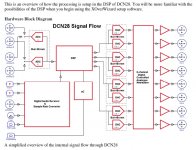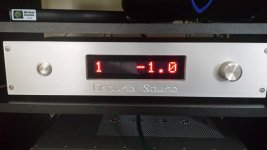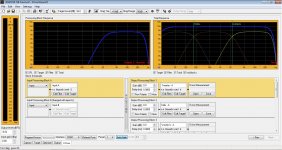I love me some stamped steel frames.If you haven't heard a Gorlich bass/mid in action, then you are just speculating.
I have.....
What would wave guides / horns either side do for SPL on the new 5" Accuton?
I'm at a loss to your critique-
first explain why everything needs to be paired with a ribbon
and secondly what side firing subs have to do with waveguides or horns
thanks
The OP did state cost no object. However, as expected, the true die hard DIY'rs have to get their shots in when something expensive gets support.
^expensive does not mean better!
But seriously, too many "high-end" drivers or speakers shine on jus one parameter
But seriously, too many "high-end" drivers or speakers shine on jus one parameter
^expensive does not mean better!
But seriously, too many "high-end" drivers or speakers shine on jus one parameter
Nobody said that. However, in some cases it could mean better.
The OP was asking about just one high-end driver.
In this case why not an ESL as midrange driver like a ESL 57 or more modern with a clever active design to help it in the low end and in the highs (Raal ?) ?
I'm at a loss to your critique-
first explain why everything needs to be paired with a ribbon
and secondly what side firing subs have to do with waveguides or horns
thanks
Mainly because I already own 9 RAAL ribbons... So my question about the wave guides / horns is to try raise the SPL of the Accuton to match the high efficient ribbons without doubling up on drivers like I did with the 12MUs.
I didn't mention side firing subs.
You'll need gigantic horns for that.
Why not do what everyone else does and you know, pad down the tweeter? Tweeters tend to be made more sensitive than mids and woofer for this very reason, so you can match the SPL required by padding it down.
Why not do what everyone else does and you know, pad down the tweeter? Tweeters tend to be made more sensitive than mids and woofer for this very reason, so you can match the SPL required by padding it down.
I've done that a couple of times before with the active x-over, seems to loose too much SQ for my liking. Might do some experimenting though by removing one of the 12MUs and see how it sounds.
Last edited:
Losing SQ by padding the tweeter by turning it down via the active xover, or losing SQ by padding it a passive lpad?
Neither is going to lose you sound quality, unless you're doing it digitally with the active xover, in which case, yes, it will lower the SQ.
Neither is going to lose you sound quality, unless you're doing it digitally with the active xover, in which case, yes, it will lower the SQ.
It looks like they are using the CS3318 as the volume control and I can tell you that in no way is going up or down 1dB going to affect the sound quality. Affect the frequency balance yes, but SQ? No.
Horn loading the accuton will not give you much gain in the upper part of its range, and you will still to attenuate your tweeters.
Regarding level attenuation of the tweeters, if you do not like digital volume control and you and do not have neither a level attenuator nor gain selector, you can still add an lpad in front of you amp (XLR pad), or after your amp (or better yet, an autoformer)
Regarding level attenuation of the tweeters, if you do not like digital volume control and you and do not have neither a level attenuator nor gain selector, you can still add an lpad in front of you amp (XLR pad), or after your amp (or better yet, an autoformer)
Probably easier (not cheaper) but doubling the drivers would give me an easy 3dB gain the same as I already have.
How do you think the C90-6-724 http://www.accuton.de/drivers/detail.php?driver=57 would go in an open baffle arrangement?
How do you think the C90-6-724 http://www.accuton.de/drivers/detail.php?driver=57 would go in an open baffle arrangement?
Hey guiys, there's a lively debate going on over in the 'lounge' forum on the subject of SQ vs measurements. Geeks only! 🙂
http://www.diyaudio.com/forums/lounge/200865-sound-quality-vs-measurements.html
http://www.diyaudio.com/forums/lounge/200865-sound-quality-vs-measurements.html
I notice that they don't have any input sensitivity adjustment. It's not clear to me how they are optimizing the noise floor on the input side. Is the problem you perceive global or only with certain program material?Well it seems to loose detail if I add or subtract even a single dB through the active x-over. Looks like it is doing it digitally in the analogue domain since it is taking place after the DAC.
I notice that they don't have any input sensitivity adjustment. It's not clear to me how they are optimizing the noise floor on the input side. Is the problem you perceive global or only with certain program material?
Sorry if I misunderstand as my electronic knowledge is very poor... but there are two ways to attenuate the signal, one in the actual device and one in the software. I believe they are taking effect at different places in the circuitry, as the one in the device is apparently the more preferable.
Attachments
Yes, the one in the software, all you need to do with this is make sure that none of the combined filters for one channel exceed 0dBfs. In other words, if you apply any gain via a filter, such as a high Q network, a peak filter, or a shelving filter - say you apply 6dB of baffle step compensation - then you will need to attenuate the signal in software by 6dB to ensure that it will never clip. Besides doing this, you should never grossly attenuate the signal with the digital processing/software side of things. It's fine to fine tune, say +- 0.5dB, but no more.
Where you should alter the volume of the various channels is via the hardware volume control built into the unit.
This is a high quality 8 channel part with independent level and group level adjustment capabilities.
In other words if you have a 4 way active system, with 4 stereo pairs, then you can set it up so that...
1) Channel 1 and 2 +5dB.
2) Channel 3 and 4 -2dB.
3) Channel 5 and 6 -8dB.
4) Channel 7 and 8 +2 dB.
On top of this you have a master volume control that will adjust them all together by a fixed amount. So if you turn the volume down all channels will go down by the same amount and if you turn it up, all channels will go up by the same amount. This lets you use the DSP box as a preamp and if you aren't already using it as a pre amp then you should. What amplification do you use?
I don't know how the DSP box is configured, but that's how it should be used for the best sound quality.
Where you should alter the volume of the various channels is via the hardware volume control built into the unit.
This is a high quality 8 channel part with independent level and group level adjustment capabilities.
In other words if you have a 4 way active system, with 4 stereo pairs, then you can set it up so that...
1) Channel 1 and 2 +5dB.
2) Channel 3 and 4 -2dB.
3) Channel 5 and 6 -8dB.
4) Channel 7 and 8 +2 dB.
On top of this you have a master volume control that will adjust them all together by a fixed amount. So if you turn the volume down all channels will go down by the same amount and if you turn it up, all channels will go up by the same amount. This lets you use the DSP box as a preamp and if you aren't already using it as a pre amp then you should. What amplification do you use?
I don't know how the DSP box is configured, but that's how it should be used for the best sound quality.
- Home
- Loudspeakers
- Multi-Way
- The best midrange driver (cost no option) for 3-way


